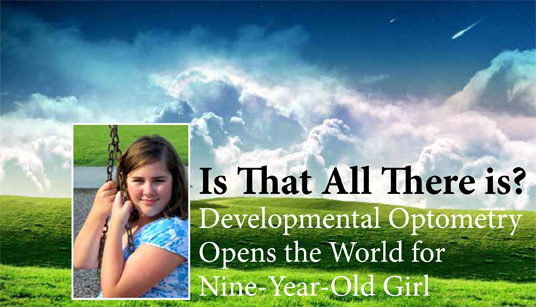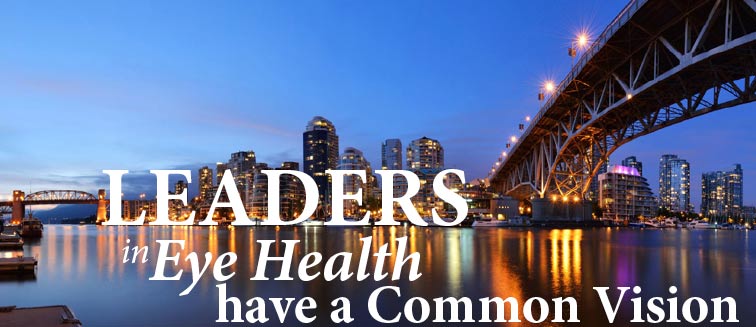By Paddy Kamen
 Jillian Benoit is now a sparkling, confident girl with big dreams. But it wasn’t always so.
Jillian Benoit is now a sparkling, confident girl with big dreams. But it wasn’t always so.
It wasn’t until Jillian Benoit was five years old that her mother Robin realized that her youngest daughter was legally blind in her right eye. “Her preschool teacher had put a patch on Jillian’s eye because they were playing pirates,” recounts Benoit. “Jillian threw her hands out in front of her as if trying to reach for something and then fell to the floor screaming and pleading for help.”
The Jacksonville, Florida mother immediately made an appointment with her pediatrician, who referred them to an ophthalmologist. The ophthalmologist supplied a name for Jillian’s condition: amblyopia, which meant she had reasonably good vision in one eye (20/30) and extremely weak vision in the other. In Jillian’s weak eye, her acuity was only six inches.
Benoit subsequently remembered things about her daughter that, in hindsight, were attributable to her vision problem, but which Benoit had assumed were simply developmental delays. These included an inability to reproduce geometric shapes with any accuracy. “She would come home with shapes she had drawn that bore very little resemblance to the triangle, square, or circle they were supposed to represent,” she notes.
In Robin Benoit’s book on the subject of her daughter’s diagnosis and treatment, Jillian’s Story: How Vision Therapy Changed My Daughter’s Life, The P3 Press, she says, “The doctor explained that there is no surgery to correct amblyopia. He said we would start her out with glasses and he would see us in six weeks. At that time, we might have to begin ‘patching’ if her vision did not improve.”
While Jillian loved her Mickey Mouse glasses, her vision did not improve and patching started in her kindergarten year. Initially, Jillian wore the patch for two hours a day after school. Robin could see that Jillian’s vision was improving, something which the ophthalmologist confirmed, increasing the patch-wearing schedule to 11 hours a day. He advised Jillian not to ride a bike or play sports while wearing the patch. And needless to say, the patch did little for her confidence.
Jillian recalls her experience of being ‘different’ from other children. “When I was younger, I thought that everyone saw like I did. Then when I was seven we went to the zoo camp at the Jacksonville Zoo. The zookeeper told us that owls have to turn their heads to see and I realized that I had to move my head the way an owl does. Before I was aware of having a vision disability, I thought that the ability to see without moving your head was a talent. I believed my sister was more talented than me because she could move her eyes instead of having to move her whole head.”
She also recalls that schoolwork became increasingly difficult: “I was always the last or second-last person to complete the work. And when the school gave out awards and treats to kids who had read the most books, I knew there was no way I could keep up with them.” Jillian’s Grade 4 teacher told Robin in an interview that her daughter needed to work faster on her handwriting and that she often left for the washroom during math class. “My brain hurts during math,” Jillian told her mom, who noticed that Jillian would often make mistakes when writing down long numerals.
When Jillian was nine, the ophthalmologist announced that she was finished with the patching treatment. Her right eye had reached an acuity of 20/40 and there was nothing more he could offer except eye drops which blurred the good eye – a drug-induced form of patching. The drops were very difficult to administer for both mother and daughter. When Robin asked the doctor about what else might be done to help Jillian, he was negative, bordering on rude. She then asked about vision therapy, something she had read about on the Internet, but the doctor said he didn’t see much value in it.
Singularly unimpressed by the doctor’s attitude and unwilling to settle for anything but the best for her daughter, Robin did more research into vision therapy and found an optometrist, Dr. James Horning. On examining the girl, Horning quickly realized that Jillian was, in fact, seeing double. She had been doing so all her life and the ophthalmologist had either failed to realize it or, if he had, hadn’t mentioned it.
Shortly afterward Jillian underwent a two-hour evaluation of her vision with Lindsey Hebert, the vision therapist who works for Dr. Horning. Hebert later structured a vision therapy program specifically for Jillian.
The vision therapy began with the development of Jillian’s gross motor skills, working with balls and balloons to learn to identify where objects are in space. And because she didn’t have the same perception on both sides of her body, Jillian worked on her balance by walking rails and doing balance board exercises. “We began this work by patching so the weaker eye learned to process information to the brain,” says Hebert.
After 12 weeks of gross motor work, Jillian began strengthening her weak eye with the use of different optical tools like lenses. These exercises helped Jillian develop better binocular vision. “Making the focusing muscles contract and then relax is a way of strengthening the focusing muscles, much like lifting weights,” Hebert explains.
To improve visual processing in Jillian’s weaker eye, Hebert used a variety of tools that had her use each eye separately and then together. “This can be as simple as using one red and one green lens in glasses. We have her look at a bright light. If she can just see green or red I know which eye is working but if she sees a mixture of the two we know that both eyes are ‘turned on’ at the same time,” says Hebert.
Depth perception is another aspect of good binocular vision, Hebert notes. “Riding a bike, playing basketball, and even playing video games require depth perception. When the eyes aren’t working well together the brain has to work that much harder to make sense of the world. When Jillian did the exercises and practiced them at home, it didn’t take long for her brain to realize that she could function more efficiently with a strong binocular visual system.”
Hebert could see that Jillian initially lacked confidence. “She had poor gross motor skills and hated physical education class. She had been struggling for a long time and was skeptical that I could help her.”
Before long, however, the girl began to emerge from her shell. “She would come bouncing in and say, ‘let’s do something fun’. She would want to try things that were difficult and it was such a joy to hear her say, ‘Look how good I am’,” recalls Hebert.
There’s no underestimating the commitment involved in completing a course of vision therapy. Jillian’s program took 45 weeks of office visits and she had to practice at home five days a week. Robin took her to all appointments and supervised the home practice. But the rewards have been incredible. Now 12 and a Grade 7 student, Jillian Benoit is a straight-A student. She’s near the top of her class in mathematics and loves science. Most importantly she has a confidence that radiates throughout her life.
Robin Benoit believes that consumers deserve eyecare professionals who make referrals for the good of the patient. “I hope my book will have an impact on the way ophthalmologists, optometrists and opticians work together to serve consumers. I’m sure they all care about the patients they see but they need to look at the big picture. We’re talking about a child’s future and parents need to know what is possible, rather than just settling for the status quo.”
Not one to settle for less than the best, Robin Benoit has, through vision therapy, given Jillian a tremendous gift. While vision therapy isn’t suitable for every vision challenge, Jillian’s story proves that it offers a whole new world of vision – and confidence – for some.











